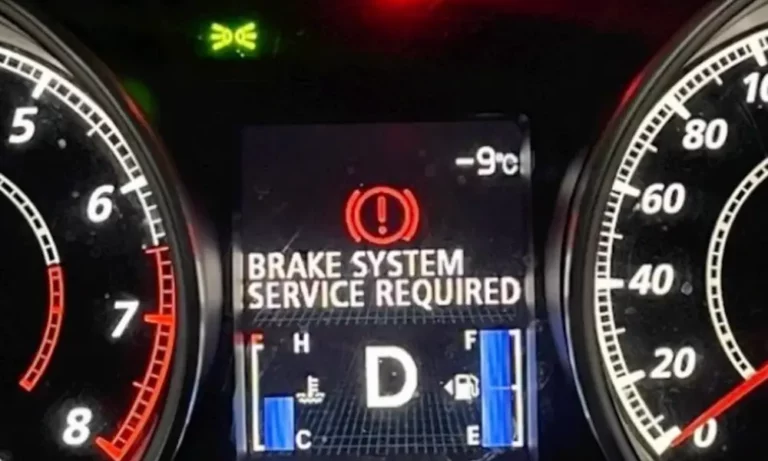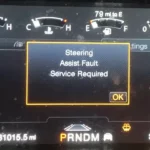Is your car showing a “brake system service required” message? This warning means your brakes might need attention, possibly due to wear or issues with components like brake pads or fluid. This issue is commonly found in Volvo and Mitsubishi vehicles. Ignoring this can lead to bigger problems down the road. Dive into this article to discover how you can fix this issue and keep your vehicle running safely.
Common Indicators of Brake System Issues
Identifying brake system issues ensures your car remains safe to drive. Look for warning lights on the dashboard and changes in how your brakes feel. These signs can suggest it’s time for a check-up or service.
ABS Light Activation
When the ABS light comes on, your car’s anti-lock braking system might have a problem. This system stops your wheels from locking up during a hard brake, which helps prevent skidding. The reason for the light could be a sensor issue, low brake fluid, or a broken ABS module.
It’s important to get it checked promptly. Your car might lose some stability during quick stops if the problem isn’t fixed. A mechanic can diagnose the ABS light issue accurately.
Service Required Message
Seeing a “Brake System Service Required” message on your dash means your brake system needs attention. This alert generally means it’s time for a detailed inspection by a professional. Possible causes include worn-out brake pads, low fluid levels, or even electronic system errors.
These messages are designed to prevent more severe damage by alerting you early. Ignoring them might cause more serious problems down the line. Regular maintenance can often prevent these messages from appearing unexpectedly.
Unusual Brake System Behavior
If you notice any unusual behavior, like a spongy brake pedal or strange noises, it might suggest something is wrong. These signs can mean air is in the brake lines or parts like calipers and rotors need checking. A soft or spongy brake pedal is a common sign of brake issues.
Sometimes, the car might pull to one side when you brake, which could mean uneven wear on the brake pads. It’s always a good idea to have a professional look at these symptoms sooner rather than later. Frequent inspections keep your brakes reliable and effective, helping you stay safe on the road.
Common Brake System Problems and Solutions
Understanding common brake system issues helps maintain your vehicle’s safety and performance. These problems often involve ABS malfunctions, traction and stability control problems, brake alignment issues, and worn components.
Addressing ABS Issues
The Anti-lock Braking System (ABS) is crucial for safe braking, especially on slippery roads. A common issue is a malfunctioning ABS. Symptoms include the ABS warning light on your dashboard. Often, a defective ABS module is the cause. To fix this, have a professional technician diagnose the module and check the wheel sensors. If wheel sensors are dirty or damaged, cleaning or replacement might be necessary. This ensures the ABS responds properly when you brake, preventing wheel lock-up and maintaining control.
Troubleshooting Traction and Stability Control
Traction and stability control systems help keep your car stable during sudden maneuvers. Problems with these systems often stem from faulty sensors or module issues. If the traction control warning light illuminates, it usually indicates a problem. Check for sensor issues or inspect the stability control module. Professionals use diagnostic tools to pinpoint and fix the problem. Maintaining these systems ensures your car adjusts power to each wheel accurately, improving overall safety during challenging driving conditions.
Fixing Brake Misalignment
Brake misalignment results in uneven wear on your brake pads and rotors. This can lead to shaking or pulling when you brake. To address misalignment, ensure proper adjustment or realignment of the brake components. Regularly inspect the brake pads and rotors for misalignment. If you notice uneven wear or unusual noises, consult a mechanic to correct the alignment. Proper alignment reduces wear on parts and improves braking efficiency, ensuring even pressure is applied when stopping.
Replacing Defective Components
Defective brake components, like worn-out pads and rotors, affect your braking power. Check for signs like squealing noises or decreased braking efficiency. Parts like the brake pads and rotor can wear over time and need replacement periodically. Inspect the brake system regularly for signs of wear and address issues promptly. Replacing defective components before they fail prevents more significant issues and ensures your brakes remain effective and safe.
Regularly servicing your brake system helps identify these problems early, avoiding costly repairs and ensuring your safety while driving.
Servicing Your Brake System
Keeping your brake system in good shape is crucial for safe driving. This will involve checking brake fluid levels, the electrical system, and evaluating various sensors and modules related to braking.
Checking and Refilling Brake Fluid
Low brake fluid can lead to poor braking performance. First, find the brake fluid reservoir, usually located near the back of the engine bay. Carefully check the fluid level and look for leaks. If the fluid is low, it needs to be refilled with the correct type of brake fluid. Use only the fluid recommended for your vehicle to avoid damaging the system. Regular maintenance ensures efficient operation and helps avoid issues like a “brake system service required” alert.
Battery Voltage and Electrical System Check
A weak battery or low battery voltage can affect your car’s braking system. It’s important to test the battery’s voltage using a multimeter. A healthy battery should read around 12.6 volts. If the reading is lower, consider charging or replacing the battery. Also, inspect battery cables for corrosion or damage. Electrical problems might impede the functioning of the ABS control module, highlighting the importance of regular checks.
Sensor and Module Inspections
Wheel speed sensors and the brake control module are key components in modern braking systems. Regular inspection of these parts can prevent problems. Check each wheel speed sensor for signs of damage or wear. These sensors help regulate braking by sending necessary data to the car’s control module. If any sensors are faulty, they may need replacement to maintain smooth and effective braking.
Brake Pressure and Control Module Assessment
Assessing brake pressure involves making sure that the control module accurately reads the pressure applied by the driver. The ABS control module should be checked for error codes or warning lights. This module plays a pivotal role in preventing wheel lockup by modulating brake pressure. Faulty readings from this module can lead to inefficient braking. Thus, regular diagnostics and servicing of the control module are crucial for maintaining safe braking.
Preventive Maintenance and Regular Inspections
Regular upkeep of your brake system is crucial for keeping your vehicle safe. Timely inspections and performing the right brake jobs ensure the brakes function properly and reduce risks. Focus on the following aspects to maintain your brake system effectively.
Scheduling Regular Brake Inspections
It’s essential to have your brakes inspected regularly to spot issues early. A brake inspection involves checking components like pads, rotors, and the parking brake system. Make sure to check for wear and tear or any signs of damage.
You should schedule inspections at least once a year. If you drive often in heavy traffic or cover many miles, consider more frequent check-ups. Regular inspections can help maintain your braking system, ensuring it stays fully functional.
Performing a Brake Job
A brake job includes tasks like replacing brake pads and checking the rotors. If your inspection shows worn-out pads or rotors, it’s time to do a brake job. This can prevent bigger problems down the road. You might also need to replace or adjust the parking brake to ensure it holds on hills.
Doing a brake job typically involves cleaning the brake components and checking brake fluid levels. Make sure you or your mechanic also check the brake lines for any leaks. Proper maintenance will keep your brakes working well and help you avoid unexpected repairs.















